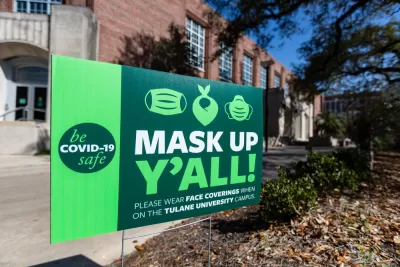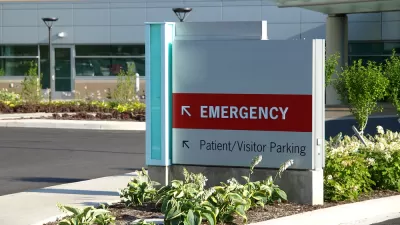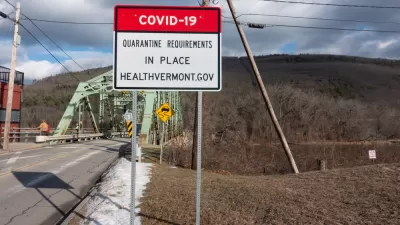We've been here many times before in the pandemic, but without the benefit of a vaccine. Gov. John Bel Edwards, one of a few governors to mandate mask-wearing indoors, warns of a collapse of the health care system, but also rules out restrictions.

"If the latest and worst COVID surge doesn’t turn a corner within the next few weeks, Louisiana’s hospitals could reach a point where care is rationed and patients are triaged," reported Blake Paterson on Aug. 13 for The Advocate, Louisiana's largest daily newspaper.
What that means is that those with the lowest likelihood of survival would be turned away and sent to hospice care.
Crisis standards of care
Paterson is referring to hospitals so overwhelmed with COVID patients that they need to invoke the dreaded "crisis standards of care."
William Haseltine, Chair and President of ACCESS Health International and a former Harvard Medical School and Harvard School of Public Health professor, explained its meaning more bluntly in a post just over a year ago describing the COVID crisis in Arizona at the time.
"It means that if you're old, you get sent home without care, and you die... We are on the brink of not treating people. There's a whole equation they are going to put into effect which says, "Are you worth treating or not?"
Fast forward to Louisiana on Aug. 13. Paterson continues:
"We are rapidly getting to the point where we could have a major failure of our health care delivery system," Gov. John Bel Edwards said at a press briefing Friday.
It’s an unimaginably grim scenario, but entirely possible given the pandemic’s current trajectory, said Dr. Joe Kanter, the state’s top public health official.
“This is not something that's happened before. We’ve never been to a place where not one hospital, but almost every hospital in the state, is at a point where they simply can’t meet the demand that comes in,” Kanter said.
But the country has been here many times before
It might be a first for hospitals in the Pelican State, but New York City was first to consider the crisis standards in April 2020, Arizona and South Texas in last year's summer surge, New Mexico in December, and California in January.
On Aug. 17, Gov. Edwards announced the extended use of the National Guard made possible through a FEMA grant enabled by President Biden.
"In Louisiana, today, we reported over 3,000 COVID hospitalizations for this first time since the beginning of the pandemic and sadly, 122 deaths, the second highest single day death count," said Edwards in a statement.
"The Guard is a critical part of what we do especially as we continue battling this devastating fourth surge of COVID driven by the highly transmissible Delta variant. On any given week, hundreds of soldiers and airmen are administering thousands of tests and vaccines, providing medical support and distributing supplies and food to food banks across the state."
Delta wave worst than original outbreak
As Edwards noted, Louisiana is experiencing a fourth, or Delta, surge, with hospitalizations nearly matching the initial outbreak when they peaked at 2,763 (7-day average) on April 12, 2020, according to The New York Times Louisiana coronavirus tracker. The 7-day average is 2,646 on Aug. 25, 2021, up 8% from two weeks ago.
Cases have started to drop
Cases are far higher now than during the prior three surges, but that's likely attributed to a lack of testing last spring. Infections peaked on Aug. 15 at a 7-day rolling average of 5,839. On Aug. 25, they averaged just below 4,700, having fallen 17% during the last two weeks. In fact, only three other states, Alabama, Missouri, and Arkansas, all hit hard by the Delta variant, reported a 14-day decrease in average new cases on Wednesday according to the Times U.S. tracker. The other 46 states are still seeing cases increase, ranging from Maine at 1% to South Dakota at 152%.
National COVID metric comparison
Louisiana and Florida have the nation's second-highest case incidence of 101 per 100,000 people, after Mississippi with 114 per 100k. The nation is averaging 45 cases per 100k on Aug. 25.
Louisiana is third in hospitalization incidence: 57 daily hospitalizations per 100k, following Florida with 80 per 100k and Alabama with 60 per 100k. The national average is 29 per 100k.
When it comes to the death rate, Louisiana is first: 1.33 per 100k, almost four times the national average. That translates to a daily death toll of 62 – the fourth highest after Florida (228), Texas (164) and California (79).
Louisiana, Arkansas, and West Virginia have the fifth-lowest vaccination level, with 40% of their populations fully vaccinated, with Alabama, Mississippi, Wyoming, and Idaho even lower. The national average is 52%.
Mitigations
Masking and social distancing, in public-health lingo called nonpharmaceutical interventions (NPIs), not vaccinations, will have the most immediate impact on reducing transmission since it takes two to six weeks to be fully vaccinated, depending on which of the three authorized or approved COVID-19 vaccines one takes.
Gov. Edward issued an indoor masking mandate on Aug. 2, making his state one of only six (along with Hawaii, Nevada, New Mexico, Oregon, and Washington—as well as Puerto Rico and the District of Columbia) to require all residents regardless of vaccination status to mask indoors as of Aug. 23, according to AARP.
On Aug. 27, Oregon will become the first state to reimpose a face-covering requirement for people in outdoor public settings.
The reason only a handful of states require indoor masking stems from the May 13 masking guidance revision issued by the CDC that exempted fully vaccinated people from masking indoors. That guidance was corrected on July 27 due to compelling vaccine breakthrough infection data collected from a Provincetown, Mass. outbreak that occurred during the July Fourth weekend.
No restrictions
"About 1 in 50 Louisiana residents have tested positive for the coronavirus since the fourth wave began at the beginning of July," continued Paterson in the source article.
And yet, Louisiana’s pandemic restrictions are as relaxed as ever, with none of the capacity limits or curfews implemented during the first three surges.
Edwards said that vaccinations and masking should be enough to stem transmission and said the U.S. Centers for Disease Control and Prevention hasn't recommended additional mitigation measures.
While Edward has gone further than most other states by issuing an indoor mask mandate, the reluctance to place restrictions on businesses and public gatherings makes it more difficult to reduce community spread, adding to the patient loads at the overwhelmed hospitals.
I'm not going to be more prescriptive than that right now," Edwards said. "Every time we've had a mask mandate before, you could see about two weeks after that was implemented, that the numbers got better, and I'm very hopeful that that's going to happen this time."
The governor was right. They peaked 13 days later.
Related in Planetizen:
- California's Hospital Crisis: What Lies Ahead, December 21, 2020
- El Paso Update: 'On the Brink of Disaster', November 13, 2020
- Another Grim Coronavirus Milestone: This Time in Southern California, August 19, 2020
- COVID Crisis Triggers Unprecedented Medical Measure in Arizona, July 9, 2020,
Hat tip to Peter Webb, editor at The Week.
FULL STORY: Louisiana's health care system nearing 'major failure' under COVID surge, says Gov. John Bel Edwards

Alabama: Trump Terminates Settlements for Black Communities Harmed By Raw Sewage
Trump deemed the landmark civil rights agreement “illegal DEI and environmental justice policy.”

Study: Maui’s Plan to Convert Vacation Rentals to Long-Term Housing Could Cause Nearly $1 Billion Economic Loss
The plan would reduce visitor accommodation by 25% resulting in 1,900 jobs lost.

Why Should We Subsidize Public Transportation?
Many public transit agencies face financial stress due to rising costs, declining fare revenue, and declining subsidies. Transit advocates must provide a strong business case for increasing public transit funding.

Paris Bike Boom Leads to Steep Drop in Air Pollution
The French city’s air quality has improved dramatically in the past 20 years, coinciding with a growth in cycling.

Why Housing Costs More to Build in California Than in Texas
Hard costs like labor and materials combined with ‘soft’ costs such as permitting make building in the San Francisco Bay Area almost three times as costly as in Texas cities.

San Diego County Sees a Rise in Urban Coyotes
San Diego County experiences a rise in urban coyotes, as sightings become prevalent throughout its urban neighbourhoods and surrounding areas.
Urban Design for Planners 1: Software Tools
This six-course series explores essential urban design concepts using open source software and equips planners with the tools they need to participate fully in the urban design process.
Planning for Universal Design
Learn the tools for implementing Universal Design in planning regulations.
Smith Gee Studio
Alamo Area Metropolitan Planning Organization
City of Santa Clarita
Institute for Housing and Urban Development Studies (IHS)
City of Grandview
Harvard GSD Executive Education
Toledo-Lucas County Plan Commissions
Salt Lake City
NYU Wagner Graduate School of Public Service





























